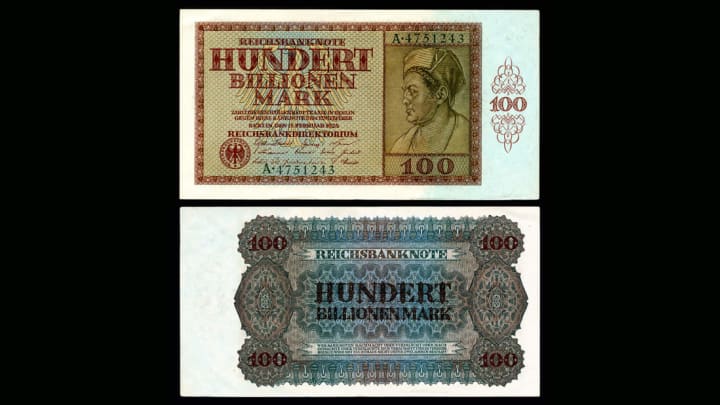Early in 1922, the German Papiermark—the currency of the Weimar Republic—was valued at around 200 Marks to the U.S. dollar. By November 1923, that figure had risen to 4,200,000,000,000. Put another way, if you had just U.S. $1 to your name, in 1920s Germany you would have been a multi-trillionaire.
How did such an absurd exchange rate come about? Precisely what set the wheels of hyperinflation and devaluation in motion in post-war Germany is debatable, but arguably the entire process began almost a decade earlier, at the dawn of the First World War.
With its efforts to secure victory in Europe in full swing, the German government opted to suspend the Mark’s gold standard—the relationship between the value of currency and the price of gold—and fund its on-going and ever-enlarging military operations by borrowing. It was an immense risk, solely reliant on one thing to succeed: Germany had to win the war.
Victory in the war, Germany presumed, would solve everything. The annexation of other European nations and their economies and assets, as well as the costly war reparations paid by the soon-to-be-defeated Allies, would together offset all the economic consequences of such a risky strategy. But unfortunately for Germany, the plan backfired. They lost the war, and by 1918, the Mark had already almost halved in value and Germany had accrued colossal international debts.
Not only that, but being on the losing side of the war meant that the costly punitive reparations the German government had intended to profit from were now being imposed on them. This only served to worsen things throughout the early 1920s, and when the government began to buy foreign currency at any price just to meet its financial obligations, the value of the Mark collapsed ever further. Inflation soon spiraled into hyperinflation—eventually peaking at a rate of 3,250,000 percent per month—and Germany quickly fell behind on its repayments.
In response, France and Belgium took control of the country’s industrial heartland, the Ruhr, in 1923, but that only served to add fuel to the fire.
The German government called on workers in the Ruhr to put down tools and resist the occupation, promising that while doing so they would continue to receive a wage from the state. The strikes, protests and campaign of passive resistance that followed all but ground industry in the Ruhr to a halt, crippling the German economy even further, while the occupation sparked a new international crisis.
For some, the occupation of the Ruhr was considered controversial and a punitive step too far. Tensions grew between the French (who had their own post-war economic problems) and the British (some of whom grew sympathetic to Germany’s position, and saw the French response as a new imperialist threat). Finally, with growing pressure from the United States, an interim agreement was drawn up by future Vice President Charles G. Dawes that lowered and staggered Germany’s reparation payments. The Ruhr occupation was brought to an end, briefly kick-starting the German economy, and for his work on the crisis Dawes was the co-recipient of the 1925 Nobel Peace Prize (the other winner was Sir Austen Chamberlain). But in the long term, the Dawes Plan failed—and even by the time it was implemented the damage to the German economy had already been done.
To combat the French occupation, the Reichsbank was being forced to churn out ever more banknotes just to function on a daily basis. Printing presses were commandeered by the state for no reason other than to print ever greater quantities of cash. In May 1923, there were 8.6 billion Marks in circulation in the country; by November there were 400 quintillion. In response, the value of the Papiermark spiraled out of control.
As the numbers on German bank notes soared to 50 trillion, daily life for the German people became increasingly absurd.

Paper currency was by now next to worthless. Employees collected their wages in wheelbarrows and suitcases more valuable than the money inside them. Banknotes were used as wallpaper and kindling to light stoves. Children played with bundles of cash in the street, cut up piles of Marks to make confetti and paper chains, and even crafted kites out of money. Shopkeepers shunned currency altogether and switched to bartering to maintain the value of their goods and services. Astonishingly, the price of one egg in 1923 would have bought you 500 billion eggs just five years earlier.
Waiters in cafés and restaurants were now reportedly mounting tables to announce price changes to their menus every 30 minutes; by the summer of 1923, patrons might sit down to a meal in a German restaurant only to find they couldn’t afford it half an hour later. One famous anecdote involves a gentleman who drank two cups of coffee, priced at 5000 Marks each, at a coffee house in Hamburg, only to be presented with a bill for 14,000 Marks. When he queried the cost with his waiter, he was told that he should have ordered the two drinks at the same time—the price had nearly doubled in the time it had taken him to drink one cup.
The crisis finally abated in the winter of 1923, when the German government introduced a new currency, the Rentenmark, backed up by the mortgage value of agricultural and commercial land. Valued at the old rate of 4.2 to the dollar, one Rentenmark was ultimately equivalent to 1,000,000,000,000 of the Weimar’s Papiermarks, and returned the Mark to the same exchange rate it had been at before the war. The “Miracle of the Rentenmark,” as it was hailed, brought to an end one of the most extraordinary periods of hyperinflation in history.
